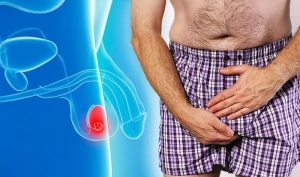Almost every man has had testicular pain at least once in his life. Among the most common causes of this condition should be noted: testicular torsion; trauma; hydrocele; varicocele; epididymal cyst (spermatocele).
Testicular torsion
When the testicles are twisted, one of the two testicles rotates inside the scrotum, which interrupts the blood supply to the organ and leads to severe and sudden pain. This pain is accompanied by redness and swelling. Testicular torsion can also cause stomach pain, nausea and vomiting.
In the case of this pathology, time plays a fundamental role. If you seek medical attention within 4-6 hours of the onset of symptoms, the prognosis is almost always excellent. Over time, the risk of permanent damage increases significantly, up to and including loss of the testicle, which can occur after about 24 hours.
Testicular torsion is more common in adolescents, but it is also possible in adulthood. The diagnosis is confirmed by ultrasound of the testicles and scrotum. An operation is required to fix the problem.
Testicular injury
Physical trauma to the scrotum or testicles can cause progressively worsening pain followed by swelling as the scrotum fills with blood. This phenomenon is usually associated with sporting events, car accidents, and the like. Treatment may be required to stop the bleeding. In some cases, anti-inflammatory drugs, ice, and an inguinal band are prescribed to support the scrotum.
Hydrocele and varicocele
A hydrocele is a buildup of fluid in the scrotum that is often mistaken for an enlarged testicle. As a rule, a hydrocele does not cause pain, unless it becomes significant. In such cases, the patient may feel discomfort even in the lower abdomen or back. As a rule, a hydrocele is treated promptly, in some cases a testicular puncture is done.
With varicocele, the veins inside the scrotum are greatly dilated. This can cause swelling and a "bump" sensation instead of the scrotum. The condition is not always painful, it can be diagnosed with a physical examination or ultrasound.
Epididymis cyst
It is a sac-like formation that resembles a hydrocele, but contains sperm rather than fluid. Its size can vary from a few millimeters to several centimeters. The cyst rarely requires surgery because it is benign. However, for especially large or painful cysts, surgery is required.
Speaking of pain in the testicle, one cannot fail to mention the so-called "reflected pain". Often there are situations when sensations in the testicle are caused by a problem that is not directly related to this organ. A similar condition can occur when:
• prostatitis;
• inguinal hernia;
• kidney stones;
• herniated disc.
Self-control: palpation of the testicles
Urologists recommend, for preventive purposes, self-examination for men at least once a month. It is advisable to do this after a shower or bath, which relaxes the scrotum, thus making it easier to detect any abnormalities.
If you find on palpation that one testicle is larger than the other, there is no need to worry (except for large differences). This is a physiological condition common to all men. Any suspicious "find" should be reported to the urologist. If you have any questions or doubts, please contact the Bogolyuby MC specialists for help.
With regular self-monitoring, you will learn to distinguish normal from any suspicious lesions. It should be remembered that early diagnosis can make a huge difference. Testicular pain requires immediate medical attention, and if the pain is severe, it is advisable to call an emergency room to quickly diagnose testicular torsion.

















